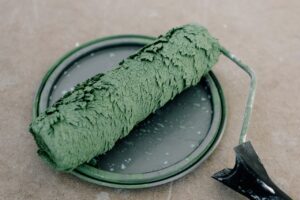
5 Ways Collaborating With An Interior Designer Elevates A Painter’s Work
Interior designers and painters share a symbiotic relationship when it comes to creating beautiful, functional spaces. Collaboration between these two professionals can significantly elevate the quality and impact of their work. In this article, we’ll explore the ways in which painters can benefit from collaborating with interior designers, and how this partnership can result in a harmonious and aesthetically pleasing environment. 1. Enhancing Color Selection One of the most crucial aspects of painting is selecting the right colors for a space. Interior designers have a deep understanding of color theory, psychology, and trends. When painters collaborate with interior designers, they can tap into this expertise to choose colors that perfectly complement the overall design of a room. Color Harmony Interior designers have an innate sense of color harmony. They can guide painters in selecting a palette that suits the space’s mood and purpose. Whether it’s a cozy living room, a vibrant office, or a soothing bedroom, interior designers can help painters choose the right hues that create a cohesive and inviting atmosphere. Avoiding Color Clashes Choosing colors without professional guidance can sometimes lead to clashes or inconsistencies in a room’s design. Interior designers can help painters avoid these pitfalls, ensuring that the chosen colors work together seamlessly. This leads to a more pleasing and visually appealing space. Staying On Trend Interior design trends are continually evolving. What was in vogue a few years ago might not be relevant today. By collaborating with interior designers, painters can ensure their work remains trendy and appealing to contemporary clients. Interior designers stay up-to-date with the latest design trends, helping painters select colors that are both timeless and fashionable. 2. Selecting The Right Finish Choosing the appropriate paint finish can make a significant difference in the overall look and feel of a room. Interior designers can assist painters in selecting the right finish to achieve the desired aesthetic and functionality. Matte, Satin, Or Gloss? Interior designers understand the nuances of different paint finishes. They can recommend the best finish for each specific space, taking into consideration factors such as lighting, traffic, and maintenance. Whether it’s a matte finish for a cozy bedroom or a glossy finish for a high-traffic area, interior designers can help painters make informed decisions. Highlighting Architectural Features Interior designers can suggest using different finishes to accentuate architectural elements in a space. This can include using a glossy finish on trim or molding to make it stand out or a matte finish to downplay imperfections on the walls. These choices can transform a room and create a unique visual impact. 3. Optimal Space Planning Space planning is a critical aspect of interior design, and it goes hand in hand with the selection of colors and finishes. Painters collaborating with interior designers can benefit from their expertise in optimizing space functionality and aesthetics. Focal Points Interior designers can identify and suggest focal points within a room, which painters can then enhance through strategic paint choices. Focal points draw the eye and create a sense of balance in the space. Whether it’s a bold accent wall or a well-painted fireplace, painters can work with interior designers to make these elements shine. Flow And Cohesion Interior designers excel at creating a sense of flow and cohesion in a space. They consider the layout of furniture, the placement of art and decor, and the flow of movement within a room. Painters can collaborate with designers to ensure that their work complements the overall design, creating a harmonious environment. Lighting Considerations Lighting can drastically affect the way colors appear. Interior designers take into account natural and artificial lighting when planning a room. Painters working in tandem with designers can adjust their color choices to accommodate different lighting conditions, ensuring that the colors appear as intended in all situations. https://www.youtube.com/watch?v=Wc8iZHGY1XQ 4. Texture And Material Selection Interior designers are experts in selecting materials and textures that enhance the visual and tactile experience of a space. Painters can benefit from this knowledge by integrating texture and material considerations into their work. Wall Treatments Interior designers can recommend various wall treatments that complement the paint job. Whether it’s textured wallpaper, wainscoting, or shiplap, these elements can add depth and character to a room. Painters can work closely with designers to ensure that their paint job integrates seamlessly with these materials. Coordinating With Furnishings The choice of furniture, textiles, and decor can greatly impact a room’s ambiance. Interior designers often have a keen eye for selecting pieces that match the overall design concept. Painters can collaborate with designers to choose paint colors that coordinate with furnishings, ensuring a harmonious look and feel. 5. Budget Optimization Collaborating with an interior designer can help painters optimize their budgets and make the most of available resources. Avoiding Costly Mistakes Interior designers can prevent painters from making costly mistakes. By providing valuable insights and recommendations, designers help painters avoid rework or the need to purchase additional materials. This not only saves money but also ensures a smoother project execution. Maximizing Value Interior designers understand the value of investing in high-quality paint and materials. They can guide painters in making choices that offer durability and longevity, ensuring that their work stands the test of time. This approach can lead to satisfied clients who appreciate the longevity and quality of the painting job. Conclusion Collaborating with an interior designer can be a game-changer for painters. The partnership brings together the worlds of color, design, and functionality to create spaces that are not only aesthetically pleasing but also highly functional. Interior designers provide painters with invaluable guidance on color selection, finish choices, space planning, texture, material selection, and budget optimization. In an industry where first impressions and visual impact are essential, the collaboration between painters and interior designers ensures that each project is a success, resulting in satisfied clients and a portfolio of work that stands out for its quality and thoughtfulness. By joining forces, these professionals can elevate their craft and create spaces that are truly









